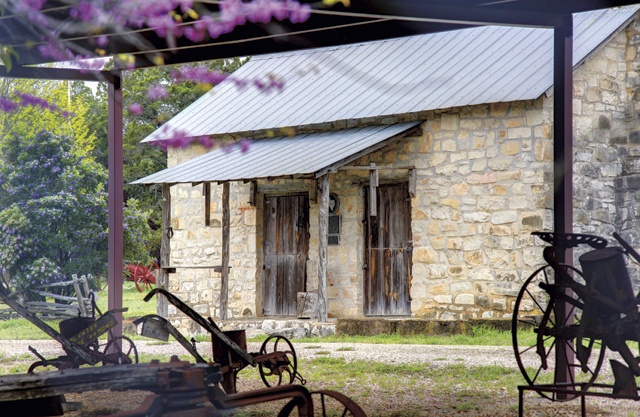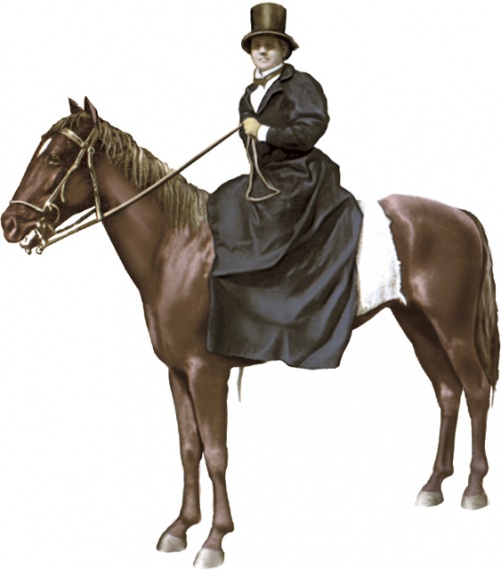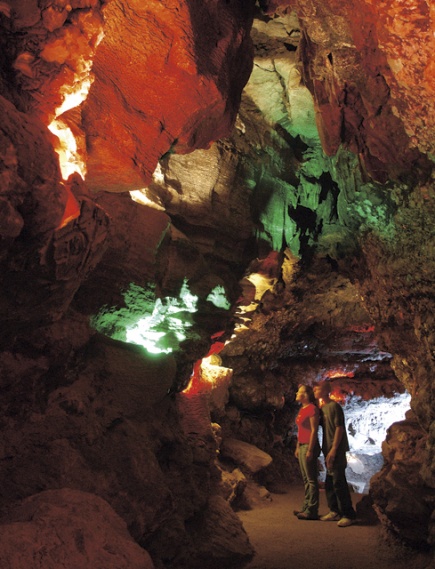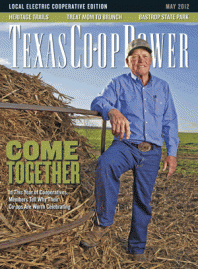Editor’s note: The Texas Heritage Trails Program is based upon 10 scenic driving trails created in 1968 by the Texas Highway Department (now the Texas Department of Transportation) and Gov. John Connally. In the first of two stories about the program, join us as we tour parts of the Hill Country Trail and Forts Trail regions, encompassing several counties in Central Texas. In the second story, scheduled for our June issue, we’ll visit three other locales—Lampasas, Mason and the Fort McKavett State Historic Site—in those same two regions.
It’s a warm, sunny Saturday in January. I’m halfway into my three-day marathon of visiting places along two Texas Heritage Trails regions, the Hill Country Trail and Forts Trail. With only another day and a half to go, I realize I’ve made a big miscalculation. I can cover only a sliver of the current and historic offerings at my six planned destinations, which comprise a mere fraction of Heritage sites across the state. Sure enough, I left each place with that feeling you get when someone takes the dessert off the table before you’ve had your fill.
For that reason, this is a two-part series. For now, I invite you to come with me to Marble Falls, Burnet and Longhorn Cavern State Park, then go explore wherever your inquisitive spirit leads you along the vast and deeply engaging Texas Heritage Trails. Who knows? You might discover something magical.
Digging Into the Story of Texas
The Texas Heritage Trails—found in 10 regions around the state—map out locations where the influence of people and events hundreds, even thousands, of years ago has been transmitted to the present and will continue into the future. Just as the sandstone blocks of Fort Mason are now part of Willow Creek Café in downtown Mason, the values and culture of those who came before us are now part of our heritage as Texans.
The Texas Historical Commission developed the Texas Heritage Trails Program, beginning with the Texas Forts Trail Region in 1998, to preserve the state’s historic sites and simultaneously promote tourism, especially in economically challenged rural areas. In 2005, the program received the national Preserve America Presidential Award for “exemplary accomplishment in the preservation and sustainable use of America’s heritage assets, which has enhanced community life while honoring the nation’s history,” according to the THC.
As I traveled through parts of the Hill Country and Forts Trail regions, I met people whose connections with their heritage and history left me wanting to dig into the story of Texas as they have, living side by side with a past that isn’t so much gone as transformed. I discovered, too, that sometimes legend survives on the edges of the facts, making for some scintillating storytelling and incentive for history sleuths to practice their craft.
The suggestions for dining, lodging and touring are based on my personal experience and are far from comprehensive. Visit the Chamber of Commerce in each town to get the full menu of options. And for in-depth information about the Heritage Trails, check out the program’s website.
Marble Falls
Adam Rankin Johnson was only 20, working as a surveyor, when he first laid eyes on a formation of thundering falls in the Colorado River in 1854. A native Kentuckian, he immediately envisioned a city with the falls at its heart and settled in Burnet County, where he married and raised a family. He left Texas to fight for the Confederacy in the Civil War and earned the rank of general for his leadership and bravery. Ironically, when he returned in 1865, the visionary of Marble Falls was blind, having been wounded by friendly fire.
Yet Johnson prevailed. He and a few investors founded Marble Falls in 1887, naming the town for what he believed was its abundant marble, which turned out to be granite. Granite was so plentiful that in 1882 the owners of nearby Granite Mountain offered to donate enough to build the present-day Capitol in Austin. Granite Mountain, at the western edge of town, covers 180 acres and is still an active quarry.
Fifth-generation Marble Falls resident Jean Eades, manager of the Marble Falls/Lake LBJ Chamber of Commerce Visitor Center, carries the town’s history in her bones. We visit the 1893 train depot, restored and relocated from its original site. It’s now the visitor center, where the period fixtures and benches, the ticket counter and the old wooden desk make it easy to imagine yourself back in the day when town life revolved around the comings and goings of the train.
The waiting room, with its potbellied stove and wooden benches with iron arms, was the hub of Marble Falls’ social life. “Back then, the depot was the center of everything,” recalled Marble Falls resident Edwin Lacy in a 1976 local newspaper interview with historian Byrna Dean Moore. “The train came in from Austin once a day and went back after it went on over to Fairland and Llano and turned around. Everybody in town who could dropped whatever they were doing and went to the depot to see who came in on the train.”
Get the whole story of how this town grew and prospered at The Falls on the Colorado Museum—learn more about Johnson’s far-reaching accomplishments and Birdie Harwood, the first woman mayor in the U.S., elected in 1917, three years before women were guaranteed by the 19th Amendment the right to vote. Harwood was endorsed by President Woodrow Wilson, who at the time was advocating women’s suffrage.
In a campaign letter she addressed to the all-male voters of Marble Falls, Harwood wrote: “There are several elective offices by women in the United States and Texas, so do not believe that in voting for women you will establish a precedent. One man actually had the nerve to run against his wife for Mayor, of course you know the result, she just snowed him under.”
After getting a dose of Marble Falls history, roam through The Shops at Old Oak Square on the site of what used to be a lumberyard. Drop in at DeSpain Barber Shop—established in 1958. You’ll think Eisenhower is still president. Stroll though Johnson Park, a lovely space to roam or enjoy a picnic, and walk over the 1939 wood and steel bridge that has been relocated from its original home over Gridiron Creek.
Insider’s Tips: Enjoy a meal at the Blue Bonnet Cafe, famous for its legendary mile-high meringue pies. How do they do that? I was there for breakfast and ordered the works: two eggs over easy, grits, bacon, biscuits and cream gravy.
Burnet
Just north of Marble Falls, the town of Burnet grew around a frontier military post. Fort Croghan, established in 1849, was organized to provide protection against Comanche and Apache raids on white settlers arriving by wagon train from the East. Just as the Colorado River attracted settlers to Marble Falls, the spring-fed Hamilton Creek drew inhabitants to Burnet.
Sixth-generation Burnet resident Carole Goble and her family are such avid boosters of their hometown that they have made the preservation of its history an intergenerational project. Goble authored a history of the town, appropriately titled Burnet. She and her children conceived of and helped raise money to create The History Plaza, a labyrinth-like maze on the courthouse grounds that visitors may walk, with markers of historic events set in chronological order.
Goble was also part of the Burnet County Heritage Society-supported creation of the Fort Croghan Museum and the reconstruction of Fort Croghan. Goble graciously leads me on a personal tour. Spend some time in the museum and enjoy the artifacts that take you from Native American arrowheads to a horse-drawn fire engine. The collection was gathered entirely from community donors. Behind the museum stands Fort Croghan, rebuilt on part of its original site, complete with the forge of Noah Smithwick, the fort’s resident blacksmith, a tiny, one-room schoolhouse and the headquarters building restored to its original condition.
Although the building served as an ammunition repository during the Civil War, it’s now outfitted as a post exchange with supplies for soldiers, such as gunpowder, saddle and tack. All the buildings are furnished with period pieces. These days, a Comanche-style tepee stands prominently on the grounds. During Fort Croghan Day, scheduled for October 13, Native Americans join frontier re-enactors in educating visitors about the spectrum of influences that shaped the area. Christmas at Ole’ Fort Croghan, set for the evening of December 8, presents another chance for visitors to get in the frontier spirit.
Insider’s Tips: Grab a bite at Tea-licious on the square. Try the signature Tuna-licious salad and order a tall glass of sweet peach tea, a house specialty. For dessert, the turtle cheesecake is a customer favorite.
And enjoy a restful night’s sleep at Airy Mount Bed and Breakfast. Originally built as a barn and carriage house, this B&B was part of Johnson’s spread. The General, aka the father of this part of the Hill Country, and his wife and six children lived upstairs in the barn while their spacious, two-story home was under construction just a few hundred yards away. Today, the B&B—run by Roseanne Hayman, who, with her husband, lives in the main residence—is a cozy, restful getaway with an eastward view of pastures and hills as far as the eye can see. Hayman is an enthusiastic and well-informed host who will gladly take a seat at the breakfast table and share the General’s colorful and fascinating stories.
Longhorn Cavern
The torrents of water rushing through it millions of years ago; the Native American rituals sheltered by its deep, underground seclusion; the Texas Rangers’ raid that rescued a white girl captured by Comanches; the Civil War soldiers hiding their gunpowder in its room-like formations; the lively crowds of the Prohibition-era underground nightclub and the 200 Civilian Conservation Corps men who excavated its entrance—all are part of the history and lore of Longhorn Cavern.
About 21 miles southwest of Burnet, Longhorn Cavern at Longhorn Cavern State Park is a wonder of nature. My tour guide, retired geologist Al Gerow, has been leading visitors (about 45,000 a year) through the two miles from entrance to exit for the past 12 years. He knows every stalactite and crystal, every hidden crevice and cave in this spacious palace of rock.
At one time, the cavern was home to millions of Mexican free-tailed bats, but they were scared away in the 1930s by noisy workers of the CCC. Taking advantage of the vacancy, Eastern pipistrelle bats moved in. These tiny creatures, unlike their Mexican cousins who live in colonies, are loners. I spot one hanging upside down, a 11/2-inch oval of brown fur with ears the size of lentils. It’s hibernating, Gerow says, shining his flashlight on its unmoving body. Come spring, this little guy and the rest of the bats will instinctively wake up and begin the nightly hunt for insects outside the cavern.
In addition to the animal life, the cave is alive with growing stalactites, resembling thick icicles made of rock. Normally, water seeping from above ground accumulates and calcifies to lengthen the stalactite formations, but the recent drought has caused them to stop growing.
The natural and human heritage of the cave is well documented, but just as interesting are the legends. One of the most repeated is about the notorious outlaw Sam Bass. According to the story, Bass and his gang used the cavern for a hideout, and somewhere in its vast network of hiding places they stashed $2 million in never-recovered gold taken in a train robbery. Is it still there? More likely, says Gerow, the story was concocted. After all, he points out, the horses couldn’t have carried that much gold in their saddlebags.
——————–
Carol Moczygemba, executive editor





